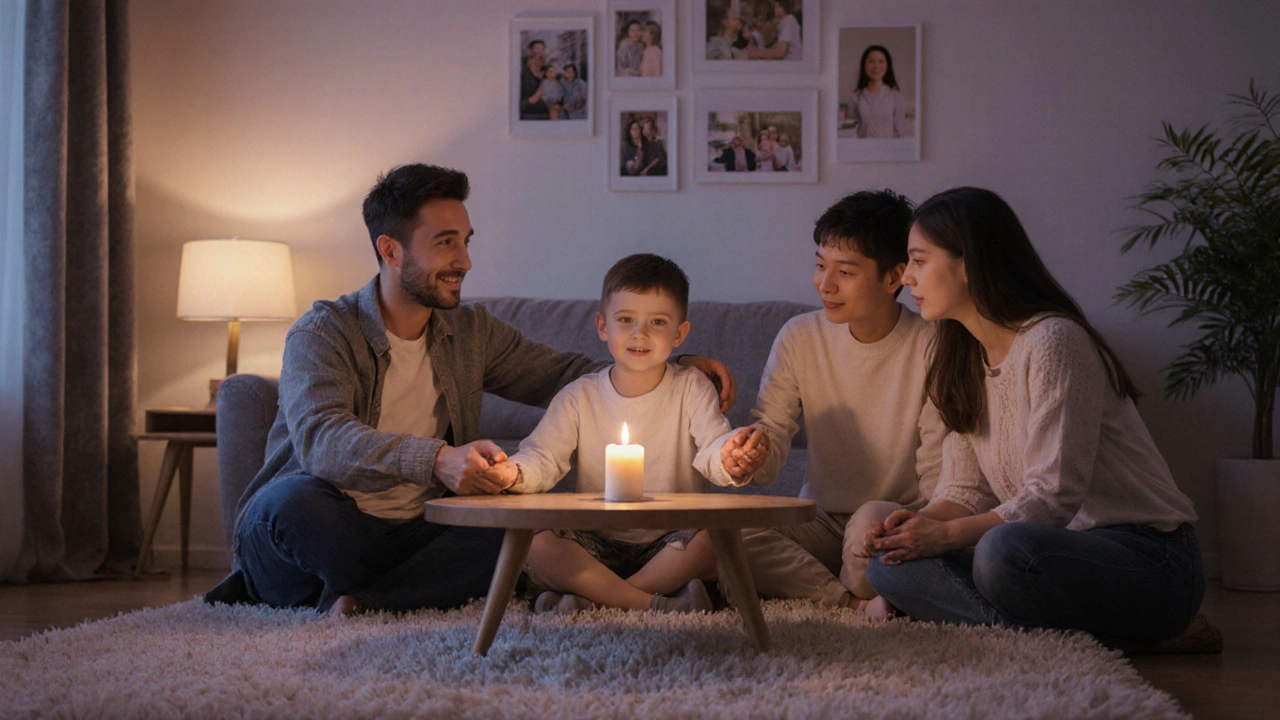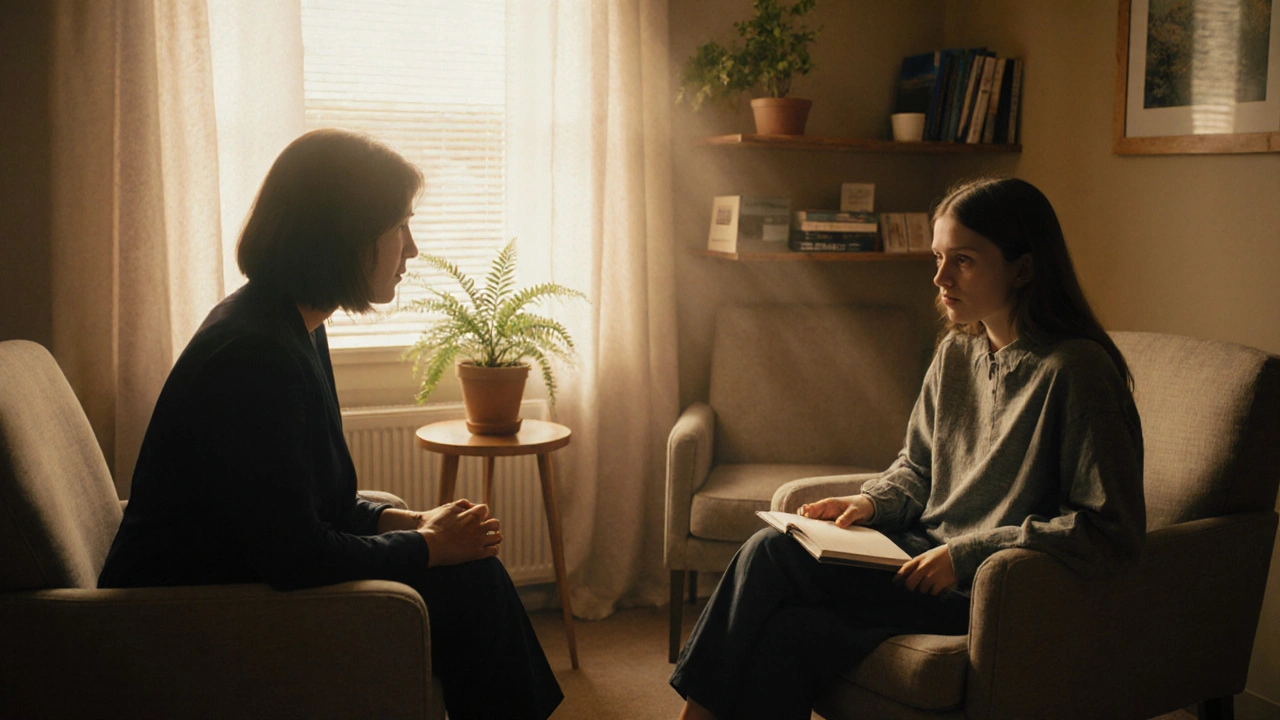TL;DR
- Rhabdomyosarcoma often triggers anxiety and depression; early recognition saves emotional wellbeing.
- Watch for mood changes, sleep trouble, or loss of interest - they’re warning signs.
- Combine professional help (therapy, medication) with daily self‑care (mindfulness, exercise, support groups).
- Family communication and clear info from your oncology team reduce uncertainty.
- Reach out to specialists the moment symptoms interfere with treatment or daily life.
When faced with Rhabdomyosarcoma a rare, aggressive soft‑tissue cancer that mostly appears in children and adolescents, most patients and families zero in on surgery, chemotherapy, and radiation. The physical battle gets all the headlines, but the emotional side can be just as fierce. Over time, many people with this diagnosis report heightened Anxiety persistent worry or fear that interferes with daily life and Depression a prolonged feeling of sadness, loss of interest, and low energy. Understanding the link between rhabdomyosarcoma mental health and these conditions is the first step toward a healthier journey.
Why a Cancer Diagnosis Sparks Mental‑Health Issues
Three main forces drive the emotional roller‑coaster:
- Uncertainty. Not knowing how the disease will progress, what side‑effects to expect, or if the treatment will succeed fuels chronic worry.
- Physical side‑effects. Pain, fatigue, and hormonal changes can mimic or amplify mood symptoms, making it hard to separate the two.
- Life disruption. School, work, and family routines get turned upside down, and the feeling of being “different” can isolate patients.
All three are magnified for Pediatric Oncology the medical specialty focused on cancer care for children and teens because kids are still learning coping skills, and parents often shoulder the emotional weight as well.
Spotting Anxiety and Depression Early
Recognizing red flags saves you from a deeper crisis. Keep an eye out for these patterns:
- Persistent worry about the future, even after a doctor’s reassuring update.
- Sleep problems: tossing, waking up early, or feeling unrested.
- Changes in appetite-eating much less or binge‑eating as a comfort.
- Withdrawal from friends, school, or favorite activities.
- Physical complaints that have no clear medical cause (headaches, stomachaches).
- Thoughts of hopelessness or self‑harm.
If any of these symptoms linger for more than two weeks, consider them a signal to act.
Professional Help: Therapy, Medication, and When to Use Them
Talking to a mental‑health specialist early can prevent spirals. Here’s a quick guide to the most common options:
| Approach | Primary Benefit | Best For | Typical Duration |
|---|---|---|---|
| Psychotherapy (CBT, ACT) | Teaches coping skills, reduces intrusive thoughts | Mild‑to‑moderate anxiety or depression | 8‑20 weekly sessions |
| Psychiatric Medication (SSRIs, SNRIs) | Balances brain chemistry, eases severe mood symptoms | Moderate‑to‑severe depression, anxiety with physical symptoms | Weeks to months, monitored regularly |
| Integrative Support (mindfulness, yoga) | Improves sleep, lowers stress hormones | Anyone looking for self‑care boost | Ongoing, short daily practice |
| Support Groups | Shares experiences, reduces isolation | Families and survivors seeking community | Weekly or monthly meetings |
Ask your oncologist for a referral to a licensed Psychotherapist a mental‑health professional trained in evidence‑based therapies. If medication seems needed, a psychiatrist familiar with pediatric oncology can adjust doses to avoid clashes with chemo drugs.

Self‑Care Strategies That Actually Work
Professional help isn’t the only line of defense. Daily habits can buffer stress dramatically:
- Mindfulness breathing. Five minutes of slow, diaphragmatic breaths lowers cortisol within minutes.
- Physical movement. Light exercise-walking, stretching, or gentle yoga-boosts endorphins and improves sleep.
- Journaling. Writing down worries separates them from reality and provides a record for your therapist.
- Creative outlets. Drawing, music, or playing video games can act as safe emotional release.
- Routine. Keeping regular meal times, school work, and bedtime anchors the day, reducing uncertainty.
When you pair these habits with a supportive network, the odds of sliding into deep depression drop sharply.
Family Communication: Turning the Team Into a Safe Space
Kids often hide their fears to protect parents. Open the dialogue early:
- Schedule weekly “check‑in” talks where everyone shares one worry and one hope.
- Use age‑appropriate language; younger children respond better to simple analogies (e.g., “the treatment is a superhero team battling the bad cells”).
- Validate feelings-don’t rush to “cheer up.” Acknowledge that sadness is a normal response.
- Invite the whole family to attend a counseling session. Having a neutral professional present keeps the conversation balanced.
Improved communication not only eases anxiety but also strengthens Quality of Life the overall wellbeing measured across physical, emotional, and social dimensions for the patient and caregivers.
When to Seek Immediate Help
Sometimes mood symptoms turn urgent. Call emergency services or go to the nearest hospital if you notice:
- Talk of self‑harm or suicide.
- Sudden, extreme agitation or aggression.
- Severe physical changes (rapid weight loss, uncontrollable vomiting) that could be a medical emergency masked as depression.
Even if the situation feels “just a phase,” it’s better to err on the side of safety. Prompt intervention can prevent a crisis from derailing treatment.
Resources and Next Steps
Here’s a quick checklist to get you moving forward:
- Write down any mood changes you’ve observed and share them with your oncology nurse.
- Ask for a referral to a Psychiatrist a medical doctor who can prescribe and monitor mental‑health medication who has experience with cancer patients.
- Locate a local Support Group a gathering of patients and families facing similar diagnoses. The Australian Cancer Society runs monthly virtual meetings that are easy to join.
- Pick one self‑care habit (e.g., a 10‑minute mindfulness app) and commit to it for two weeks.
- Set a family meeting every Friday to discuss what’s working and what needs adjustment.
By tackling anxiety and depression head‑on, you protect both the emotional and physical sides of the fight against rhabdomyosarcoma.

Frequently Asked Questions
Can anxiety make my child’s chemotherapy less effective?
High stress can affect the immune system and may heighten side‑effects, but it doesn’t directly cancel out chemo drugs. Managing anxiety improves overall tolerance and helps keep appointments on schedule.
Is it safe for my teen to take antidepressants while undergoing treatment?
Yes, when prescribed by a psychiatrist aware of the chemo regimen. Many SSRIs have minimal interaction with standard sarcoma drugs, but monitoring liver function is essential.
What age is appropriate for a child to join a cancer support group?
Most groups welcome children 7 years and older, offering age‑graded sessions. Younger kids often benefit from play‑therapy groups instead.
How can I tell if my partner’s depression is a reaction to my diagnosis or something else?
Look for timing (did symptoms start after the diagnosis?) and specific triggers (financial worry, caregiving stress). A professional counselor can help separate cancer‑related distress from pre‑existing mood issues.
Are there any online tools that help track mood during treatment?
Apps like Moodpath, Daylio, or the Australian eHealth portal allow daily mood logging, which can be shared with your therapist during appointments.


The fight against rhabdomyosarcoma isn’t just about chemo and radiation; it’s a battle for the soul.
Parents who ignore the mental toll are doing a disservice to their children.
A pinch of compassion, a dash of honest dialogue, and you can turn anxiety into a manageable guest.
Remember, silence breeds monsters, while open talk can dissolve them.
So lace your daily routine with empathy and watch the darkness recede.
Here’s the thing most folks overlook: the pharma giants have a vested interest in keeping patients dependent on medication.
The very therapies touted for mood stabilization are often laced with subtle neuro‑modulators that muddy judgment.
Trust the official guidelines at your peril; independent research reveals alternative pathways that aren’t being advertised.
Keep your eyes peeled, the system loves a compliant patient.
I’ve seen families turn the tide simply by carving out a quiet moment each day to breathe together.
Even when the clinic walls feel like a maze, a shared laugh can reset the nervous system.
It’s amazing how much resilience blooms when you validate a child’s fear instead of brushing it off.
Small rituals like a nightly gratitude note can stitch together a sense of control.
Keep fostering those tiny victories, they add up.
It’s striking how often a brief check‑in can surface something that would otherwise stay hidden.
When a teen mentions “I’m just tired” it could be more than chemo fatigue.
A calm, non‑judgmental ear helps them separate physical weariness from emotional drain.
Encourage them to note shifts in mood, even if they seem minor.
That data becomes a powerful tool for the care team.
Let’s get straight to the point: the brain‑body connection in cancer patients is a textbook case of systemic dysregulation.
Modern psychiatry often ignores the quantum stress fields that pervade the tumor micro‑environment.
By integrating psychoneuroimmunology protocols you can actually modulate cytokine storms.
This isn’t speculation; multiple peer‑reviewed studies corroborate the mechanism.
So don’t settle for generic CBT; demand a tailored neuro‑feedback approach.
Oh yeah, because a breathing exercise totally cures chemo nausea.
When you sit down each morning and commit to a 10‑minute mindfulness session, you’re not just calming the mind, you’re actively rewiring neural pathways that have been hijacked by stress.
Research shows that consistent diaphragmatic breathing reduces cortisol levels within minutes, giving the body a biochemical reprieve.
Pair that practice with gentle stretching or a short walk, and you trigger the release of endorphins that counteract the fatigue from chemotherapy.
Even a modest increase in daily activity can improve circulation, which helps the immune system operate more efficiently.
Journaling, meanwhile, offers a concrete outlet for racing thoughts, allowing the patient to externalize worries and track patterns over time.
When patterns emerge, therapists can pinpoint triggers and adjust coping strategies with surgical precision.
Creative outlets such as drawing or playing an instrument serve a dual purpose: they distract from pain while fostering a sense of agency.
Support groups provide social proof that you’re not alone in this fight, reducing the isolation that often fuels depressive spirals.
Family meetings that allocate a few minutes for each member to voice concerns build a safety net of emotional transparency.
It’s crucial to involve a psychiatrist who understands the pharmacokinetics of chemotherapy, ensuring that any prescribed SSRI does not interfere with treatment metabolism.
When medication and therapy are synchronized, patients report higher adherence to their oncology appointments.
Consistent sleep hygiene-such as a dark bedroom, limited screen time, and a regular bedtime-stabilizes the circadian rhythm disrupted by hospital schedules.
Nutrition plays an underrated role; balanced meals with omega‑3 fatty acids support brain health and mood regulation.
Hydration, often overlooked, maintains neurotransmitter balance and reduces the sense of mental fog.
All these habits, when woven into a routine, create a resilient framework that can buffer the emotional upheaval of a cancer diagnosis.
Ultimately, the synergy of professional support and self‑care empowers patients to reclaim a modicum of control in an otherwise unpredictable journey.
That’s a solid roadmap – I’d add that checking in with a pediatric psychologist early can personalize the steps and keep the family from feeling overwhelmed.
Totally agree, and don’t forget to set a simple weekly goal, like a 5‑minute stretch routine, so the whole crew can track progress without stress.
From a cultural standpoint, many families find strength in community rituals – sharing a meal or a traditional song can create a sense of continuity that eases the mental strain.
The interplay between uncertainty and resilience is fascinating; notice how a clear plan for school re‑entry often steadies a teen’s mood more than medication alone.
Indeed, the anticipation of structured routine forms a philosophical anchor, reminding us that even in chaos we can carve out islands of meaning.
I’ve seen quiet evenings with a single cup of tea do wonders for calming the mind after a long treatment day.
It is with profound solemnity that we observe the shadowed corridors of the psyche when malignancy looms, for the soul, once enshrouded in terror, seeks refuge in the luminous vestiges of hope.
Yet, the stark reality remains: without deliberate intervention, despair may take root, inexorably intertwining with the physiological ravages of disease.
Therefore, a concerted engagement of psychiatric expertise, coupled with the compassionate stewardship of caregivers, emerges as an indispensable bulwark against the encroaching abyss.
While the sentiment is admirable, the preceding paragraph suffers from a regrettable overuse of semicolons and misplaced commas; a more succinct construction would enhance clarity.
Wow, another “deep” post about breathing – because apparently inhaling solves everything, right? 🙄
People need to know that simple breathing can actually help, not just be a joke.
Listen up, folks – you can’t just tell families to “stay positive” and walk away. Real support means giving them the tools, not the clichés, and that starts with honest talk about the tough stuff.